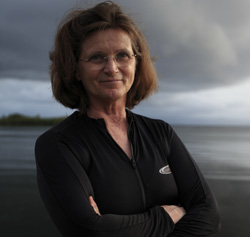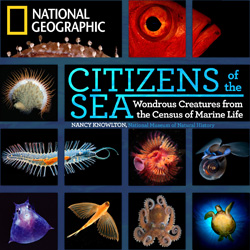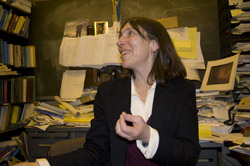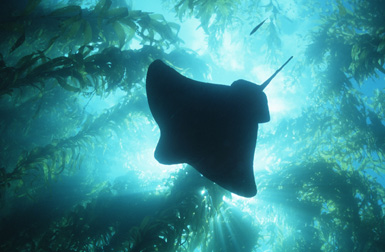One fish, two fish ...
Scientists spend a decade
taking a census of world's oceans
Ioana Patringenaru | Jan. 24, 2011

Nancy
Knowlton, an adjunct professor at Scripps, is the author of "Citizens of the Sea," a book outlining findings from the 10-year Census of Marine Life.
If you could weigh all the microbes living in the ocean, they would weigh more than all the big fish. Some fish commute across the Pacific Ocean just like we commute to work. There are more bacteria in the ocean than stars in the universe. Every other breath you take comes from oxygen generated by marine organisms.
These are some of the discoveries highlighted in “Citizens of the Sea,” a new book by Nancy Knowlton, an adjunct professor at UCSD's Scripps Institution of Oceanography. The 216-page volume flew off the shelves and went out of print in just three months at the end of 2010. It’s now in its second printing. The book outlines findings from the decade-long Census of Marine Life, an international effort to get a better grasp of what lives in the oceans.
Researchers hope the census, which ended last year, will provide a baseline against which they’ll be able to monitor future changes. The oceans already are in trouble because of overfishing, pollution along the coastlines and greenhouse gas emissions, which are making waters warmer and more acidic, scientists found.
“We can’t really take the ocean for granted,” said Knowlton, who also works for the Smithsonian in Washington, D.C. “We need to start paying attention to it. Otherwise we’ll have mass extinctions.”
Knowlton is one of several UC San Diego researchers who played a role in the census. In addition to writing "Citizens of the Sea," she co-led the effort to better understand coral reefs. Meanwhile, Lisa Levin, also of Scripps, took part in census field expeditions, including a cruise just off the Chilean coast during a major earthquake. Karen Stocks, of the San Diego Supercomputer Center, developed an online database to help describe marine organisms living in seamounts.
“It wasn’t just about counting fish and taking samples in the ocean,” said Levin. “It was about diversity.”
Diversity in the oceans is valuable because marine ecosystems do a lot of things for us, said Knowlton. Organisms clean water. Reefs protect coastal communities. The ocean also yields plants and organisms used in commercial products. For example, seaweed can be found as an ingredient in everything from tooth paste to chocolate milk. Toxins found in sea snails hold the promise of potential lifesaving drugs, Knowlton said.
There is still so much we don’t know about the world’s oceans, she added. They constitute 95 percent of the planet’s habitable real estate, yet more people have been to the moon than to the Mariana Trench, in the oceans’ deepest reaches.
So for the past decade, 2,700 scientists from more than 80 nations set out to shed some light on all that unknown. They embarked on 540 expeditions and wrote more than 2,600 papers.
Innovative methods
Meanwhile, Knowlton sailed to Hawaii and Australia to investigate coral reefs. She also worked in the lab to develop techniques that could be used to identify marine life without having to name it or describe it in the first place. The method relies on DNA analysis at the molecular level and allowed researchers to detect hundreds and hundreds of new species.
It’s a good example of the innovative methods census researchers used. Another is the development of dollhouse-like underwater habitats that scientists dropped at about 600 coral reef sites. They came back to pick them up after a year and looked at what moved in. “It’s a really useful method because it allowed us to make comparisons with a standard technique,” Knowlton said.
Stories from the ocean

Knowlton's
book already is in its second printing.
But she admits she perhaps had the most fun crafting “Citizens of Life,” a 216-page book designed to explain the census’ findings for a lay audience. “I’ve been a marine biologist for 35 years,” she said. “So I asked myself: What ocean stories would be most fund to tell?”
The book is organized in 14 thematic sections with catchy titles, like “Appearance is Everything,” about why sea organisms blend in or are conspicuous, and “For What It’s Worth,” about the oceans’ value for humanity. Each section includes four to eight individual stories illustrating that theme. They’re diabolically short, at about 350 words each. “I got very good at it,” Knowlton said. “I really wanted to have details in each story.”
Cruise off Chile

Lisa Levin in
her office at Scripps.
Meanwhile, Levin, a biological oceanographer at Scripps, sailed as far as New Zealand and Chile. The Chilean expedition was observing organisms living in hot hydrothermal vents and cold methane seeps. The cruise was run by graduate students and that allowed Levin to spend more time looking at organisms and working on the science. “It was great fun,” she said.
Then, on Feb. 27, an 8.8 earthquake hit Chile, leaving hundreds dead and a good part of the country in ruins. The crew of the R/V Melville turned over the ship's radio communication systems to Chilean researchers on board who were trying to reach their families. Luckily, no one lived or worked near the epicenter of the tremor. Levin herself felt a connection. A marine laboratory where she spent a sabbatical had been wiped away by the tsunami that followed the quake. Scientists did their best to continue their research while dealing with the impact of that tragedy. “The scientific work goes on,” Levin said.
Surprising diversity
Asked what surprised her the most about the census’ findings, Knowlton said she was blown away by the sheer amount of life forms scientists found. “There’s just so much life out there that we didn’t know was there,” she said.

Fast-growing giant kelp
form cold-water forests that many fish, like this stingray, invertebrates and mammals call home.
For example, in coral reefs, researchers decided to focus on crabs. There’s already a pretty good database documenting known species and new species are easy to analyze genetically, Knowlton said. Researchers found that in just six square yards of coral reefs, there are as many crab species as 80 percent of all the crab species that have been described in all of Europe. “That was just staggering for us, that you’d just get so much diversity in a minuscule sample,” she said.
Stocks, of the San Diego Supercomputer Center, helped scientists keep track of some of that diversity. She has been developing the Seamounts online database, which supports the census’ efforts to better understand underwater mountains. Researchers have been able to explore new regions, discover new species and document human impact on seamounts—and record their findings in Stock’s online database. Researchers also recorded nearly 30 million observations of 120,000 species in the Ocean Biogeographic Information System, the census’ global marine life database.
Now that they’ve established this impressive baseline, where do the researchers go from here? They will meet this fall in Aberdeen, Scotland, to decide on the next steps to take, Knowlton said.
“The age of discovery is now,” she said. “There’s so much left to do.”
Mario Aguilera contributed to this report.

|